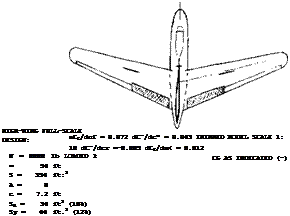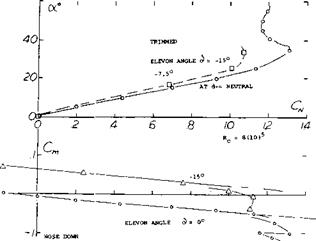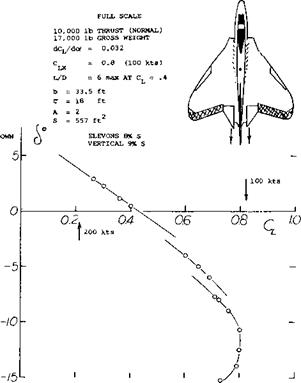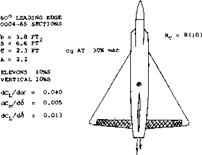CHARACTERISTICS OF TAILLESS CONFIGURATIONS
Considering performance (drag), tail surfaces are basically an operational necessity, usually not contributing to lift. Also, to support them in their conventional place, the fuselage must be made longer than it would have to be, just to house payload and equipment. During some 40 years of aviation history, therefore, the idea has been advanced, discussed (27), investigated and partly converted into hardware, of flying without a tail in a wing – only airplane.
Stability of Airfoil (26). The pitching moment of an airfoil section, about an assumed CG (on chord line) is
C, n,-C„0 + (Ax/c)CL (48)
where x = g – a = distance between CG and AC (which may be at ^ 24% c). The stability derivative
dCm3/dCL = Д. x/c (49)
is negative = stable, as long as the CG is located ahead of the AC, ie, forward of ~ 24% of the chord. In order to obtain balance, it is now necessary to keep
Cm0+ (Дх/с) CL = zero; or CrnD= — (Дх/с) CL (50)
This can be done by changing camber such as deflecting a trailing edge flap. For positive lift coefficients, an airfoil section with reflexed camber line promises to be most efficient. Such a section (with Cmo= 0) can then be trimmed to a desired positive lift coefficient by pulling the flap up. Theoretically, stable and balanced flight can thus be obtained in a simple wing. For example, for a CG location at 22% c, the static stability derivative may be 0.22 — 0.24 = 0.02. Using derivatives as found in the Chapter IX, the required deflection of a 20% flap, would be 6 ^ – 4 CL. For each additional % of the chord through which the CG is moved forward, another A(d$/dCL ) = – 2 will be required.
Wing Sweep. A tailless airplane, simply relying on the qualities of a straight wing, is likely to be very sensitive. The wing would provide too little damping (about the lateral axis). A swept wing (having a longer length, between apex and rear end of the lateral edges) would, therefore, be more suitable, using the wing tips for stabilization and control. Considering the areas near the tips to be a pair of horizontal tail surfaces, we then have a configuration which is basically similar to the conventional wing plus tail arrangement. The wing tips can and have also been used to carry a pair of vertical fins, to provide directional stability and control. One of the first such airplanes built and flown was by Dunne in 1910. This airplane was propelled by a pusher propeller, conveniently located “in” the center of the configuration. An early British development was the “Pterodactyl” (28,a, b). Several similar airplanes (most of them gliders) were designed and built by Lippisch (28,c).
Wing Flaps in or near the center of the wing, could “never” be balanced in a straight-wing tailless airplane. However, as explained in the “wing” chapter, the center of the lift produced by trailing-edge flaps, is (at least theoretically) at or slightly ahead of 50% of the chord. Therefore, in-a sufficiently swept wing, inboard flaps can produce lift at a location ahead of the wing’s aerodynamic axis. As proposed in (28,b) such flaps could then also be used for pitch control; and their d(ACL)/dCL would be positive rather than negative (as explained above for ele – vons), when using them as “elevators”.
Swept-Forward Another solution to control a tailless airplane, is to sweep the wing forward, as for example, in the design in figure 39. The configuration can be trimmed by pulling up the inboard flaps. Using the average tested value dCrr/dcf0 = 0.005, a flap deflection S° = 8 is needed, for example, to balance the moment at CL = 1.0. It seems however, that conditions (and shortcomings) basically remain as they are in a swept-back wing configuration.
(26) Wurster, Analysis and Experimental Investigation of Stable (swept and twisted) Wings, Ybk D Lufo 1937 p 1-115. [107]
(28) Consideration of tailless airplanes:
a) Hill, Tailless Airplane, J RAS 1926 p 519.
b) Jones, Stability & Control, NACA TN 837 (1941).
c) Lippisch, “Storch” Glider, L’Aerophile Feb 1930 p 35 (NACA TM 564); also “Dreieck I”, NACA AC-159 (1932).
d) Donlan, Stability & Control, NACA T Rpt 796 (1944).
(29) Characteristics of tailless airplanes, tested:
a) Weick, Swept Wing, NACA TN 463 (1933).
b) Lippisch, “Storch” Type, Ybk D Lufo 1937 p 1-300.
c) Gates, “Pterodactyl” Design, ARC RM 1423 (1932).
d) Stone, Cornelius Glider, NACA W Rpt L-738 (1946).
e) Brewer, Northrup in F’Scale Tunnel, W Rpt L-628 (1944).
f) Tailless Airplane, see NACA W Rpts L-42 and L-50.
|
В * 2(10)’’ |
|
|
 |
|
|
|
|
|
|
|
|
|



 Interceptor. The research efforts reported in (28,c) and (29,b) eventually led to the first rocket-powered and “tailless”, operational airplane (31). Here as in many other configurations designed without a special horizontal control surface, one can argue whether a vertical surface is a tail or not. Apart from delta designs, one of the very few operational tailless airplanes is or was the U. S. Navy’s F7U-1 “Cutlass” fighter (33). To provide directional stability, this airplane carries a pair of fins (above the wing), each approximately at Уі span. Principles of tailless airplanes and some results of model tests are presented in
Interceptor. The research efforts reported in (28,c) and (29,b) eventually led to the first rocket-powered and “tailless”, operational airplane (31). Here as in many other configurations designed without a special horizontal control surface, one can argue whether a vertical surface is a tail or not. Apart from delta designs, one of the very few operational tailless airplanes is or was the U. S. Navy’s F7U-1 “Cutlass” fighter (33). To provide directional stability, this airplane carries a pair of fins (above the wing), each approximately at Уі span. Principles of tailless airplanes and some results of model tests are presented in
(32) .
Conclusion. After reviewing various aspects of tailless airplanes, it may seem that the original idea of saving wetted area (by combining, at least the horizontal tail with the wing) will not necessarily reduce drag. A larger wing area will most likely result, and larger vertical fins. It has also been explained in (27) that size and speed of the airplane are to be considered together with the problem of the tail. In particular, modern high-speed airplanes have fuselages which are large in comparison to the wings. As a consequence:
(a) The original idea of stowing away everything within the wing, can no longer be realized.
(b) The fuselage is available anyhow as a “boom” to carry both the vertical and the horizontal tail surfaces.
However, there can always be reasons apart from performance, to make a tailless airplane desirable. One such type of configuration is delta-wing fighter airplanes. See Chapter XVIII.
Trim Required. Results of flight tests on a full-scale carrier-based jet airplane are reported in figure 41. The discontinuities in the elevon deflection are confirmed by corresponding jumps in the stick force. They seem to be a consequence of the automatic leading-edge slats as shown in the illustration. For the CG location as tested, the elevon angle corresponds to d6/dCL = – 14 . Assuming that other derivatives might be similar in magnitude to those of the model in figure 40, the static stability may be
dCm/dCL = – (dCm/d6) (d6/dCL ) = – 0.005 (14) = – 0.07
|
(32) Donlan, Longitudinal and Lateral Characteristics of Tailless Airplanes, NACA T Rpt 796 (1944). (33) U. S. Navy “Cutlass” F7U-1, by Chance Vought, “fastest Navy fighter in production”; see Jane’s All the World’s Aircraft 1952, or “Aero Digest” Annual Directory 1951 p 37. b & 40ft W * 27,0001b V, & 600 kts Tx « 10,0001b |
in the condition as tested. The neutral point of the airplane would then be at 24.4 + 7.0 = 31.4% of the “mac”. The trimmed maximum lift coefficient (C^ := 0.8) is obtained with the help of 6 = – 11 or – 12°. It seems that the slats make the elevons more effective at higher angles of attack, although they do not help to increase the maximum operationally obtainable lift.












